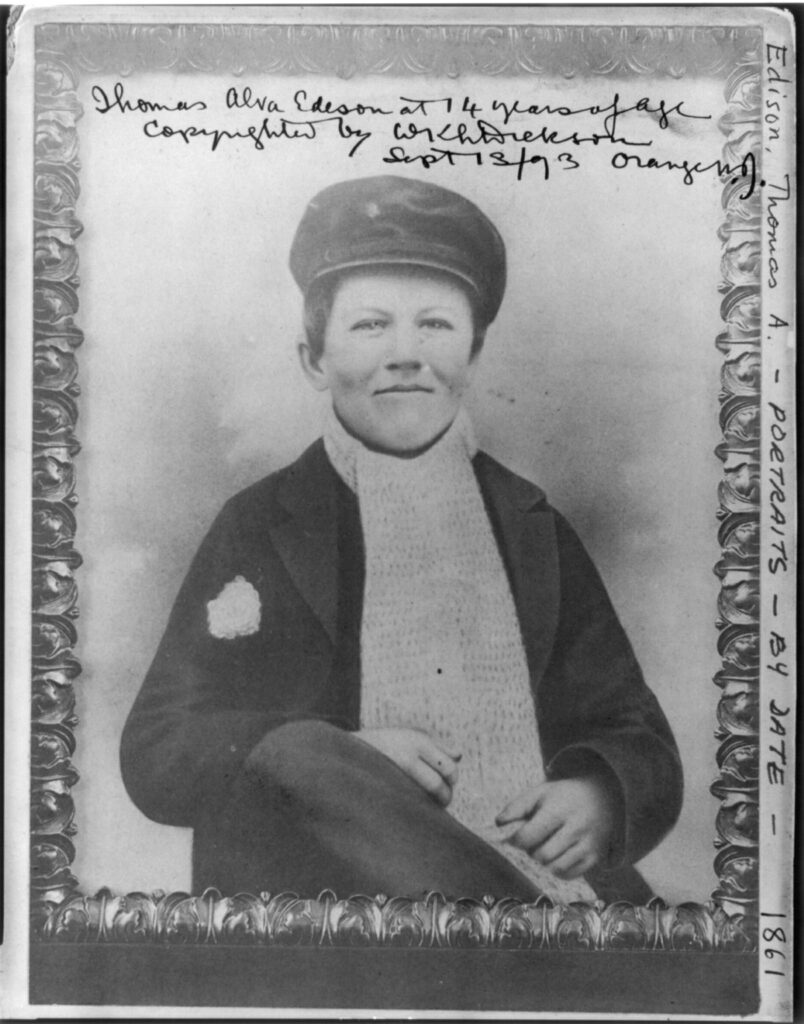The Man Who Made the Modern World

There wasn’t much about the boy to suggest that he would be the father to the 20th century. Thomas Alva Edison was the seventh child of his parents and the fourth to survive to adulthood. He developed hearing problems when young and, while not totally deaf as an adult, he was very hard of hearing. He wrote, “I have not heard a bird sing since I was 12 years old.” Given his many inventions, it’s surprising that Edison never invented a hearing aid, although he often said he was working on one. But growing up deaf, he realised, had helped him, allowing greater concentration on his work and tuning out the “babble of ordinary conversation”.
Born on 11 Februay 1847 in Milan, Ohio, the young Edison had little schooling and what he had provided little of worth: he learned by reading – he was a lifelong, voracious and omnivorous reader – and doing. One of Edison’s first jobs was selling sweets and newspapers to railway passengers. During his breaks, the young Edison did chemistry experiments in the baggage car.

Telegraphy was the communication breakthrough that, together with the railroad, was opening up the vast expanses of the United States. In 1863, at the age of 16, Edison became an apprentice telegrapher and, naturally for him, started experimenting on improvements and by January 1869 he had done enough to believe that his future lay in being a full-time inventor.
That future lay in New York, which was where Edison moved, working initially on improvements to telegraphy so that it was possible to send four signals down one wire at once. Edison’s work on the quadriplex, as this new system of telegraphy was called, was snapped up for $100,000. There was serious money in these new-fangled inventions.

Unfortunately, Edison’s talents did not stretch to money management, and neither did those of his young bride, 16-year-old Mary Stilwell, so the couple moved away from the financial temptations of the city to Menlo Park, New Jersey, which was then a quiet rural backwater. At Menlo Park Edison built the world’s first research and development laboratory, combining a lab and machine shop.
It was here that Edison earned the soubriquet, ‘The wizard of Menlo Park’, creating many of the inventions that would usher in the modern, technological world. But these were not just the result of Edison: one of his unsung but crucial talents was his ability to bring together and motivate a team of skilled designers, technicians and engineers. In part this was because every member of the team was positively encouraged to note down ideas and bring them to the rest of the team. Good ideas were pursued by all. Edison’s working methods were unlike those that typified most scientific research. Rather than investigating experimentally the predictions of a theory, Edison pursued hunches, interests, anything that caught his fancy, treating every setback as a new avenue towards greater understanding. When some expensive chemicals were left out in sunlight and degraded, rather than bemoan the loss, Edison stopped all his other experiments and had his team investigate the properties of the degraded chemicals. Everything was interesting and, sometimes, useful. As Edison said, “Genius is hard work, stick-to-it-iveness, and common sense.” But the combination of gifts Edison brought together was far from common.

Edison’s research at Menlo Park produced the carbon microphone that made telephones a world wide technology, the basic design continuing in use for the next century; devised a system of electricity distribution that allowed the first widespread use of electric lights; devised the first cinema camera, known as the ‘Kinetograph’; and invented the electric light bulb. The neon-lit, connected, fame-obsessed world of the 21st century has its origin in Edison’s inventions in the second half of the 19th century.
On 9 August 1884, Edison’s wife, Mary, died. She was 29. The couple had three children. Edison remarried two years later, his new bride being 20-year-old Mina Miller. Edison was now 39. He had three more children with his new wife, moving with her to a new home and research complex in West Orange, New Jersey. The new facility saw the development of alkaline batteries, the foundation of the cinema industry and the production of commercial phonographs but, being larger and less intimate, it was not as conducive to the sort of small-team work that was the foundation for Edison’s most remarkable inventions. However Edison, ever the workaholic, continued working there until his 80s.
Thomas Edison died on 18 October 1931 at his home. The world around him was a very different place to that into which he had been born and probably no single man had changed it more than he had.
0 Comments